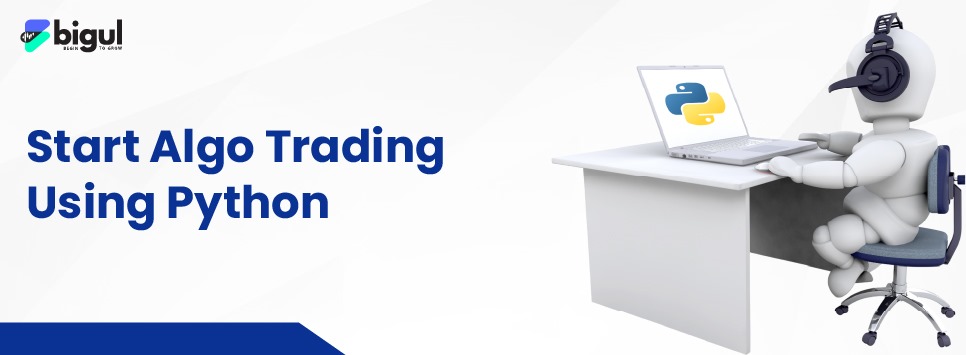Algo Trading using Python will be one of the best choices in 2025 as nowadays, lots of traders are shifting to automated trading from traditional trading. To achieve success on your journey into Algorithmic Trading using Python, it's essential to understand both the foundational concepts of trading and the technical skills required to implement automated strategies. Here, we will guide you through the necessary steps to start algo trading using Python.
Also Read | How DeepSeek AI Can Benefit Stock Market Traders?
What is Algo Trading?
Algo Trading, or Algorithmic Trading, refers to the use of computer algorithms/program to execute trades based on predefined criteria. Python is one of the widely used languages for making Algorithms for Automated Trading. Traders make Algorithmic based on their predetermined strategies with properly defined parameters such as buying price, stop loss, trailing points, etc. This method allows for high-speed transactions and can significantly reduce human error. In India, the percentage of traders using Algo Trading and deploying Algo Trading strategies varies, but the range is generally 50% to 60%.
Here's a categorised breakdown based on the latest data
Percentage of Algo Trading in India
· Overall Usage:
o Reports indicate that approximately 50% to 55% of traders in India utilise Algorithmic Trading methods.
o A more recent update suggests that this figure has increased to around 60%, particularly in high-frequency trading (HFT) contexts.
· Institutional vs Retail Traders:
o Among institutional traders, a significant majority (about 97% of Foreign Portfolio Investors (FPIs) and 96% of proprietary traders) uses Algorithmic Trading for executing trades, which shows its dominance in professional trading environments.
o Only about 13% of individual retail traders engage in Algo Trading, indicating a big difference in adoption rates between retail and institutional market participants.
Global Comparison
In comparison to India, Algorithmic trading has a much larger share of total trading volume in developed markets:
o Approximately 80% of equity transactions globally are executed via Algorithms.
o In the US and Europe, this figure ranges from 60% to 85%, shows how Algo Trading is more uses in these markets compared to India.
Why Use Python for Algorithmic Trading?
Python is one of the leading and widely used programming languages for Algo Trading in 2025 due to its simplicity, available powerful libraries and large community. Here are some reasons why Python would be the best choice to make Algo Trading strategies:
- Ease of Learning: Python's syntax is very easy to use, making it easy to deploy and create algorithms for Automated Trading.
- Libraries: Python offers Libraries such as Pandas for data manipulation, NumPy for numerical calculations, and Matplotlib for data visualisation which is important to create any Algo Trading strategy.
- Community Support: Python has a vast community provides resources, tutorials, and forums that help traders troubleshoot issues and learn new techniques.
Getting Started with Algorithmic Trading in Python
Step 1: Setting Up Your Coding Environment
Let’s setup your environment:
- Install Python: To Download the latest version of Python visit the Python official website by clicking here.
- Choose an IDE: Integrated Development Environments (IDEs) like Jupyter Notebook, Visual Studio or PyCharm provide you an editor where you can code your Algo Trading strategy fast.
- Create a Virtual Environment (Optional): Create a separate Python environment for your automated trading project, this is an optional step. You can use local or global environments as well. Use the following commands in your command prompt or terminal:
- Install necessary Libraries: This is the very important step to make your automated strategy on Python run the below command into terminal to install the necessary Python libraries
Step 2: Understand Basic Trading Concepts
Make yourself familiar with basic trading concepts such as:
- Market Orders vs Limit Orders: Know when to use each type based on your Algo Trading Strategy.
- Technical Indicators: Learn about indicators like Moving Averages, RSI (Relative Strength Index), and MACD (Moving Average Convergence Divergence) that help in decision-making.
Step 3: Start Coding Your First Strategy
This is a simple Algorithm created to generate the buy and sell signal of 'RELIANCE INDUSTRIES' using Simple Moving Average crossovers. Use your own understanding, research and backtest to create and deploy any Algo Trading strategy.
Step 4: Backtest Your Strategy
Backtesting your trading strategy using historical/past data is crucial to evaluate the effectiveness and accuracy of your Algo Trading strategy. You can utilize Python libraries like backtrader or zipline for this purpose, or you can use online platforms to backtest your Algo Trading strategy.
Step 5: Implementing the Strategy with APIs
This is one of the most important steps to make your Algo Trading strategy fully functional and execute trades automatically; you'll need to integrate the broker's API with your Python program. Popular APIs include:
- Bigul Bonanza API: One of the easiest to use and implement in your Algo Trading Strategy, to completely manage from order punching to risk management is easy, all with low latency.
- Interactive Brokers API: Suitable for international trading.
Make sure to read the API documentation of respective API providers thoroughly to understand how to place orders programmatically in your Python or any language programs.
Step 6: Risk Management
Risk management is very important approach in trading and so is in when you deploy you strategy on Algorithm. Effective risk management strategies are vital in Algorithmic Trading. Implementing stop-loss orders and keeping managed position size is effective step to protect your capital.
Advanced Topics in Algorithmic Trading
Once you're comfortable with basic strategies, you can explore more advanced Algo Trading concepts:
- Machine Learning: Integrate machine learning models using libraries like Scikit-Learn to predict market movements based on historical data, Python language would come beneficial here as well to implement.
- High-Frequency Trading (HFT): Learn about strategies that involve executing a large number of orders at extremely high speeds.
- Sentiment Analysis: Implement sentiment analyse techniques in you Algo Trading strategy using news articles or social media sentiment to gauge market trends.
Resources for Further Learning
To read more about Algo Trading such as basic Algo Trading strategies, how Algo Trading facilitates growth protection of wealth in Stock Market, Algo Trading vs Traditional Trading, other Algo Trading concepts and many more by visiting here.
Conclusion
Starting Algo Trading using Python may seem headache at first, but breaking it down into manageable steps makes it achievable even for beginners in stock market. With Python even having a decent foundation in both programming and trading concepts, you'll be well-equipped to develop sophisticated trading Algorithms that can operate autonomously in the financial markets.
FAQ
1. What is algorithmic trading in Python?
Algo trading in Python uses computer programs to automatically execute trades based on predefined rules. It analyzes market data and executes trades when specific conditions are met using Python programming language.
2. Can I use Python to start algorithmic trading in 2025?
Yes, Python is ideal for algo trading in 2025 due to its simple syntax, powerful libraries (Pandas, NumPy), and extensive community support.
3. What is the success rate of algorithmic trading?
Algo trading success rates vary by market and trader type. Institutional traders show 97% adoption rates, while about 50-60% of all trades in India are algorithmic. Developed markets like the US show higher rates of 60-85%.
4. How long does it take to learn algo trading with Python?
With basic programming knowledge, expect 3-6 months to learn the essentials of algorithmic trading with Python, including trading concepts, strategy creation and API integration.
5. Can I do algorithmic trading without coding?
While no-code platforms exist, learning Python gives you more control and flexibility to create automated trading strategies. Beginners can start with simple tools and learn coding gradually.
Also Read:
- Algo Trading vs Traditional Trading: Which Approach is Right for You?
- Algo Trading: Revolutionising the Way We Trade and Invest
- Mastering Algo Trading: Strategies for Success in Automated Trading
- How Algo Trading Facilitates Growth Protection of Wealth in Stock Market









.jpg)
.jpg)
